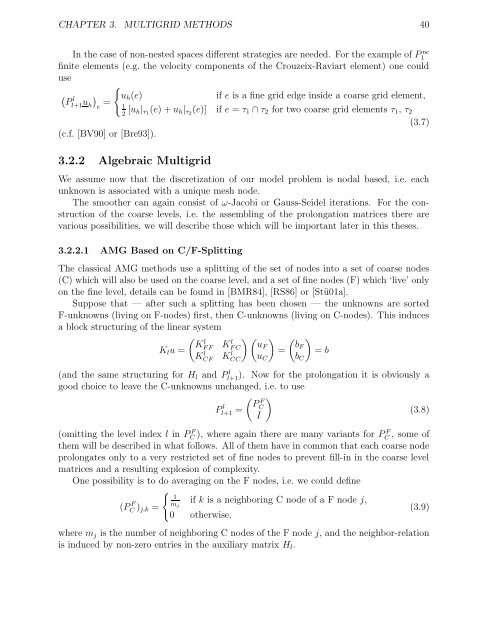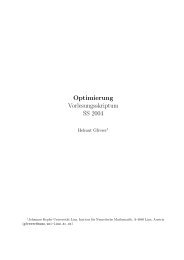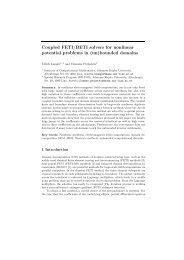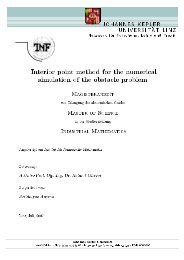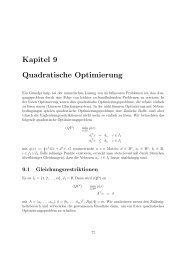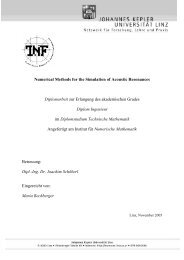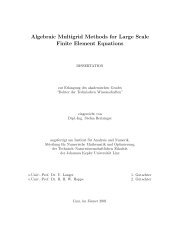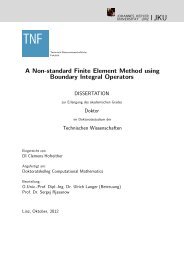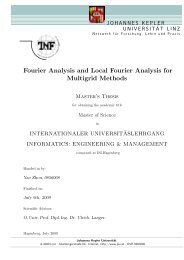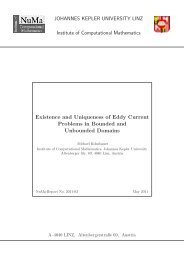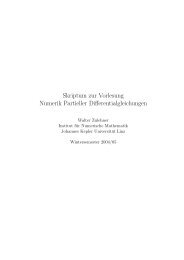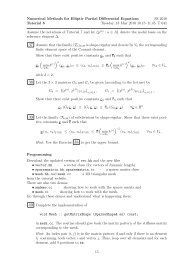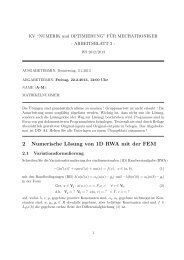PDF file - Johannes Kepler University, Linz - JKU
PDF file - Johannes Kepler University, Linz - JKU
PDF file - Johannes Kepler University, Linz - JKU
Create successful ePaper yourself
Turn your PDF publications into a flip-book with our unique Google optimized e-Paper software.
CHAPTER 3. MULTIGRID METHODS 40<br />
In the case of non-nested spaces different strategies are needed. For the example of P1<br />
nc<br />
finite elements (e.g. the velocity components of the Crouzeix-Raviart element) one could<br />
use<br />
{<br />
( )<br />
P<br />
l<br />
l+1 u = u h (e)<br />
if e is a fine grid edge inside a coarse grid element,<br />
h e 1<br />
[u 2 h| τ1 (e) + u h | τ2 (e)] if e = τ 1 ∩ τ 2 for two coarse grid elements τ 1 , τ 2<br />
(3.7)<br />
(c.f. [BV90] or [Bre93]).<br />
3.2.2 Algebraic Multigrid<br />
We assume now that the discretization of our model problem is nodal based, i.e. each<br />
unknown is associated with a unique mesh node.<br />
The smoother can again consist of ω-Jacobi or Gauss-Seidel iterations. For the construction<br />
of the coarse levels, i.e. the assembling of the prolongation matrices there are<br />
various possibilities, we will describe those which will be important later in this theses.<br />
3.2.2.1 AMG Based on C/F-Splitting<br />
The classical AMG methods use a splitting of the set of nodes into a set of coarse nodes<br />
(C) which will also be used on the coarse level, and a set of fine nodes (F) which ‘live’ only<br />
on the fine level, details can be found in [BMR84], [RS86] or [Stü01a].<br />
Suppose that — after such a splitting has been chosen — the unknowns are sorted<br />
F-unknowns (living on F-nodes) first, then C-unknowns (living on C-nodes). This induces<br />
a block structuring of the linear system<br />
(<br />
K<br />
l<br />
K l u = F F KF l C<br />
KCF<br />
l KCC<br />
l<br />
) ( )<br />
uF<br />
=<br />
u C<br />
(<br />
bF<br />
)<br />
= b<br />
b C<br />
(and the same structuring for H l and Pl+1 l ). Now for the prolongation it is obviously a<br />
good choice to leave the C-unknowns unchanged, i.e. to use<br />
( ) P<br />
Pl+1 l = F<br />
CI (3.8)<br />
(omitting the level index l in PC F ), where again there are many variants for P C F , some of<br />
them will be described in what follows. All of them have in common that each coarse node<br />
prolongates only to a very restricted set of fine nodes to prevent fill-in in the coarse level<br />
matrices and a resulting explosion of complexity.<br />
One possibility is to do averaging on the F nodes, i.e. we could define<br />
{<br />
1<br />
(PC F ) m<br />
j,k = j<br />
if k is a neighboring C node of a F node j,<br />
(3.9)<br />
0 otherwise,<br />
where m j is the number of neighboring C nodes of the F node j, and the neighbor-relation<br />
is induced by non-zero entries in the auxiliary matrix H l .


